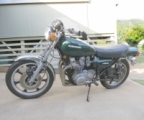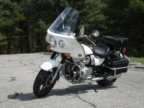KZ1000 rear caliper
- Kapahulu
-
 Topic Author
Topic Author
- Offline
- User
- Posts: 568
- Thanks: 44
KZ1000 rear caliper
24 Nov 2010 13:52 - 24 Nov 2010 14:03
When I bought this '79 KZ1000 the rear master cylinder was inoperative and dry. I picked up a new used one from E-bay. Today I installed the master, filled it with fluid and bled it. Now the brake works, however it also drags on the disc.
So I'm trying to think of the best way to fix this. Maybe take off the back wheel and pump the brake 'till the brake piston pops out, then clean everything up?
I don't know if it needs a rebuild, doesn't appear to have any fluid leaks.
Suggestions please?
So I'm trying to think of the best way to fix this. Maybe take off the back wheel and pump the brake 'till the brake piston pops out, then clean everything up?
I don't know if it needs a rebuild, doesn't appear to have any fluid leaks.
Suggestions please?
1978 KZ1000, 1976 KZ900, 1975 H2, 1973 H1, 1973 H2, 1978 RD400, 1977 RD400, 1974 RD350
2strokeworld.com
2strokeworld.com
Last edit: 24 Nov 2010 14:03 by Kapahulu.
Please Log in or Create an account to join the conversation.
- oldkaws4ever
-

- Offline
- User
- Have no regrets...... You only live once.
- Posts: 1642
- Thanks: 11
Re: KZ1000 rear caliper
24 Nov 2010 14:01
I went through this when i put GPZ 900 calipers on my z1. Take it all apart and clean it good and you should be good to go. I ended up putting a GSXR 1000 rear master cylinder on the z1 when i upgraded to mag wheels, i am going to be getting a ZX10R front master cylinder and doing away with the splitter in the front and just run my lines from the calipers to the master. Im going to order one of these too.
www.z1enterprises.com/detail.aspx?ID=3975
www.z1enterprises.com/detail.aspx?ID=3975
74 Z1a 900 (Apart and making it better than ever)
77 Kz 650b (Threw a rod, going to sandwich in a 900 or 1000 motor)
76 Kz 400d
05 ninja zx-636
81 Kz 750 Ltd
Darien, Illinois
77 Kz 650b (Threw a rod, going to sandwich in a 900 or 1000 motor)
76 Kz 400d
05 ninja zx-636
81 Kz 750 Ltd
Darien, Illinois
Please Log in or Create an account to join the conversation.
- Kapahulu
-
 Topic Author
Topic Author
- Offline
- User
- Posts: 568
- Thanks: 44
Re: KZ1000 rear caliper
01 Dec 2010 14:06
This brake has two pistons (I didn't know that before I took it apart). I popped one piston out and cleaned it up easily enough. The other one was locked in there solid. Anyways, the brake doesn't drag now and I don't use the back brake much anyways. Maybe the other piston will eventually free up.
1978 KZ1000, 1976 KZ900, 1975 H2, 1973 H1, 1973 H2, 1978 RD400, 1977 RD400, 1974 RD350
2strokeworld.com
2strokeworld.com
Please Log in or Create an account to join the conversation.
- BSKZ650
-

- Offline
- User
- Posts: 2064
- Thanks: 14
Re: KZ1000 rear caliper
01 Dec 2010 16:40
seems to me like you should fix it right, then you know there is not a issue,, BTW, mine has a rear disc on it and only one piston, not sure what you might have.
also, I like to go with DOT 5 fluid when I rebuild the brakes, just a better product
also, I like to go with DOT 5 fluid when I rebuild the brakes, just a better product
77 kz650, owned for over 25 years
77 ltd1000, current rider
76 kz900, just waiting
73 z1,, gonna restore this one
piglet, leggero harley davidson
SR, Ride captian, S.E.Texas Patriot Guard Riders.. AKA KawaBob
77 ltd1000, current rider
76 kz900, just waiting
73 z1,, gonna restore this one
piglet, leggero harley davidson
SR, Ride captian, S.E.Texas Patriot Guard Riders.. AKA KawaBob
Please Log in or Create an account to join the conversation.
- Patton
-

- Offline
- KZr Legend
- Posts: 18640
- Thanks: 2100
Re: KZ1000 rear caliper
01 Dec 2010 20:19
May find these threads to be of interest.
kzrider.com/index.php?option=com_kunena&...d=5&id=411688#411742
kzrider.com/index.php?option=com_kunena&...limitstart=20#411508
Good Fortune!
kzrider.com/index.php?option=com_kunena&...d=5&id=411688#411742
kzrider.com/index.php?option=com_kunena&...limitstart=20#411508
Good Fortune!
1973 Z1
KZ900 LTD
KZ900 LTD
Please Log in or Create an account to join the conversation.
- Kapahulu
-
 Topic Author
Topic Author
- Offline
- User
- Posts: 568
- Thanks: 44
Re: KZ1000 rear caliper
01 Dec 2010 21:42
BSKZ650 wrote:
I also tried air pressure and no results.
If anyone can tell me how to get that frozen brake piston out, I'll be glad to do it. It's the outboard piston. I tried pumping it out with the brake lever and used a rubber mallet on it - the piston might already be fully retracted because it didn't budge.seems to me like you should fix it right
I also tried air pressure and no results.
1978 KZ1000, 1976 KZ900, 1975 H2, 1973 H1, 1973 H2, 1978 RD400, 1977 RD400, 1974 RD350
2strokeworld.com
2strokeworld.com
Please Log in or Create an account to join the conversation.
- Patton
-

- Offline
- KZr Legend
- Posts: 18640
- Thanks: 2100
Re: KZ1000 rear caliper
02 Dec 2010 06:13
Kapahulu wrote:
 Have other methods discussed in above posted links such as soaking, grease, heat, freezing, etc., already been attempted?
Have other methods discussed in above posted links such as soaking, grease, heat, freezing, etc., already been attempted? 
Good Fortune!
BSKZ650 wrote:If anyone can tell me how to get that frozen brake piston out, I'll be glad to do it. It's the outboard piston. I tried pumping it out with the brake lever and used a rubber mallet on it - the piston might already be fully retracted because it didn't budge.seems to me like you should fix it right
I also tried air pressure and no results.
Good Fortune!
1973 Z1
KZ900 LTD
KZ900 LTD
Please Log in or Create an account to join the conversation.
- oldkaws4ever
-

- Offline
- User
- Have no regrets...... You only live once.
- Posts: 1642
- Thanks: 11
Re: KZ1000 rear caliper
02 Dec 2010 07:14
I would take the caliper apart and spray some carb cleaner or break cleaner over the stuck piston and very carefully take some chan o locks and wiggle the piston side to side till it comes out. It works for me every time 
74 Z1a 900 (Apart and making it better than ever)
77 Kz 650b (Threw a rod, going to sandwich in a 900 or 1000 motor)
76 Kz 400d
05 ninja zx-636
81 Kz 750 Ltd
Darien, Illinois
77 Kz 650b (Threw a rod, going to sandwich in a 900 or 1000 motor)
76 Kz 400d
05 ninja zx-636
81 Kz 750 Ltd
Darien, Illinois
Please Log in or Create an account to join the conversation.
- TomW
-
- Offline
- User
- Keep the blue side up.
- Posts: 502
- Thanks: 52
Re: KZ1000 rear caliper
02 Dec 2010 10:27
BSKZ650 wrote:
"seems to me like you should fix it right,"
I agree. The stuck piston will probably migrate back out and you'll have a sticky caliper again.
"I like to go with DOT 5 fluid when I rebuild the brakes, just a better product"/quote]
Maybe not better, but certainly different. An alarm went off in my brain, so I Googled this up.
"More than you ever wanted to know about brake fluid....
Brake fluid facts
By Steve Wall
As a former materials engineering supervisor at a major automotive brake system supplier, I feel both qualified and obligated to inject some material science facts into the murky debate about DOT 5 verses DOT 3-4 brake fluids. The important technical issues governing the use of a particular specification brake fluid are as follows:
*
Fluid compatibility with the brake system rubber, plastic and metal components.
*
Water absorption and corrosion.
* Fluid boiling point and other physical.
* Brake system contamination and sludging.
Additionally, some technical comments will be made about the new brake fluid formulations appearing on the scene.
First of all, it's important to understand the chemical nature of brake fluid. DOT 3 brake fluids are mixtures of glycols and glycol ethers. DOT4 contains borate esters in addition to what is contained in DOT 3. These brake fluids are somewhat similar to automotive anti-freeze (ethylene glycol) and are not, as Dr. Curve implies, a petroleum fluid. DOT 5 is silicone chemistry .
Fluid Compatibility
Brake system materials must be compatible with the system fluid. Compatibility is determined by chemistry, and no amount of advertising, wishful thinking or rationalizing can change the science of chemical compatibility. Both DOT 3-4 and DOT 5 fluids are compatible with most brake system materials except in the case some silicone rubber external components, such as caliper piston boots, which are attacked by silicon fluids and greases.
Water absorption and corrosion
The big bugaboo with DOT 3-4 fluids always cited by silicone fluid advocates is water absorption. DOT 3-4 glycol based fluids, just like ethylene glycol antifreezes, are readily miscible with water. Long term brake system water content tends to reach a maximum of about 3%, which is readily handled by the corrosion inhibitors in the brake fluid formulation. Since the inhibitors are gradually depleted as. Since the inhibitors are gradually depleted as they do their job, glycol brake fluid, just like anti-freeze, needs to be changed periodically. DOT 5 fluids, not being water miscible, must rely on the silicone (with some corrosion inhibitors) as a barrier film to control corrosion. Water is not absorbed by silicone as in the case of DOT 3-4 fluids, and will remain as a separate globule sinking to the lowest point in the brake system, since it is more dense.
Fluid boiling point
DOT 4 glycol based fluid has a higher boiling point ( 446°F) than DOT 3 ( 446 ºF), and both fluids will exhibit a reduced boiling point as water content increases. DOT 5 in its pure state offers a higher boiling point (500°F) however if water got into the system, and a big globule found its way into a caliper, the water would side at temperatures very much below freezing, let alone at 40° below zero, silicone's low temperature advantage won't be apparent. Neither fluids will reduce stopping distances.
With the advent of ABS systems, the limitations of existing brake fluids have been recognized and the brake fluid manufacturers have been working on formulations with enhanced properties. However, the chosen direction has not been silicone. The only major user of silicone is the US Army. It has recently asked the SAE about a procedure for converting from silicon back to DOT 3-4. If they ever decide to switch, silicone brake fluid will go the way of leaded gas.
Brake system contamination
The single most common brake system failure caused by a contaminant is swelling of the rubber components (piston seals etc.) due to the introduction of petroleum based products (motor oil, power steering fluid, mineral oil etc.) A small amount is enough to do major damage. Flushing with mineral spirits is enough to cause a complete system failure in a short time. I suspect this is what has happened when some car owners changed to DOT 5 (and then assumed that silicone caused the problem). Flushing with alcohol also causes problems. Older brake systems should be flushed only with DOT 3 or 4.
If silicone is introduced into an older brake system, the silicone will latch unto the sludge generated by gradual component deterioration and create a gelatin like goop which will attract more crud and eventually plug up metering orifices or cause pistons to stick. If you have already changed to DOT 5, don't compound your initial mistake and change back. Silicone is very tenacious stuff and you will never get it all out of your system. Just change the fluid regularly. For those who race using silicone fluid, I recommend that you crack the bleed screws before each racing session to insure that there is no water in the calipers.
New developments
Since DOT 4 fluids were developed, it was recognized that borate ester based fluids offered the potential for boiling points beyond the 446°F requirement, thus came the Super DOT 4 fluids - some covered by the DOT 5.1 designation -which exhibit a minimum dry boiling point of 500°F (same as silicone, but different chemistry).
Additionally, a new fluid type based on silicon ester chemistry (not the same as silicon) has been developed that exhibits a minimum dry boiling point of 590°F. It is miscible with DOT 3-4 fluds but has yet to see commercial usage."
I learned in the past thru others mistakes not to switch to DOT 5 in systems designed for DOT 3 or 4.
Tom
'78 KZ1000B2 LTD stock + Vetter Fairing & luggage
'91 ZG1200B5 Voyager XII, stock
'91 ZG1200B5 Voyager XII, stock
Please Log in or Create an account to join the conversation.
- ezrider714
-
- Offline
- User
- Posts: 256
- Thanks: 38
Re: KZ1000 rear caliper
02 Dec 2010 12:56
Agreeance no DOT 5 fluid on bikes
78 KZ650SR Mine since 79
4-1 Mac Jet Hot coated since mid 80's
Dyna Coils
Saddlebags (I ain't skeered of going nowhere)
4-1 Mac Jet Hot coated since mid 80's
Dyna Coils
Saddlebags (I ain't skeered of going nowhere)
Please Log in or Create an account to join the conversation.
- P21
-

- Offline
- User
- Posts: 471
- Thanks: 34
Re: KZ1000 rear caliper
02 Dec 2010 17:39
to the poster.
i would hate to see you have a rear brake lockup at any given speed.
do the job right and save yourself from nasty road rash.
brakes on a bike is nothing to brush off!!!!!!
i hope you the best and ride safe
this is only my .02 worth
i would hate to see you have a rear brake lockup at any given speed.
do the job right and save yourself from nasty road rash.
brakes on a bike is nothing to brush off!!!!!!
i hope you the best and ride safe
this is only my .02 worth
Kawasaki KZ 1000 Police (2002) P21
Please Log in or Create an account to join the conversation.

